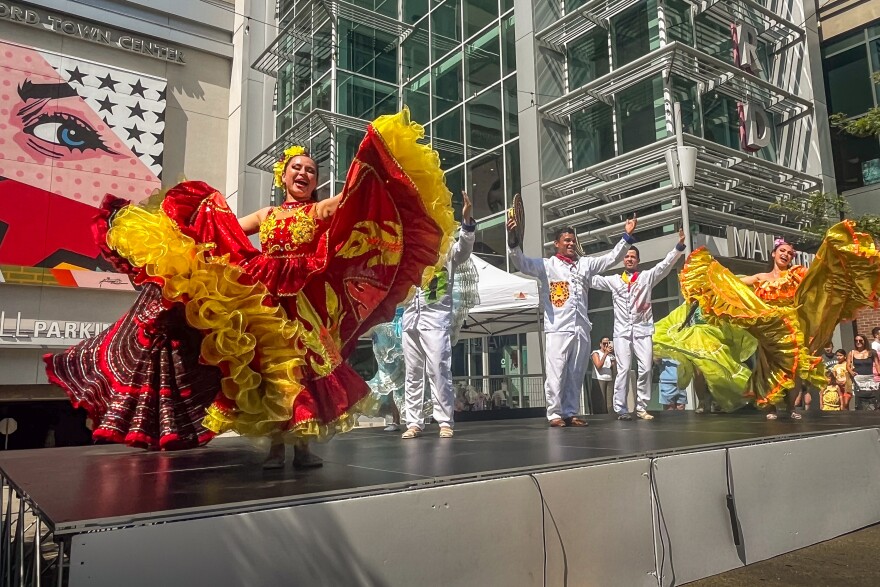At the Stamford Town Center, Elsa Bohorquez dances to Colombian folk music known as vallenato while wearing a long, flowy yellow skirt. She’s joined by her daughter Cielo Urrego, who wears a red skirt, and Gina Bohorquez in a blue skirt.
As they twirl around each other, it looks like the Colombian flag is dancing with them.
“I’m here to celebrate Independence Day in Stamford,” Elsa Bohorquez said in Spanish. “Even though I have to work [in the morning], I’m here to enjoy.”
Colombians celebrate Independence Day on July 20 because on that day in 1810, an uprising in the capital Bogotá started Colombia’s War of Independence against Spain. That war ended in 1819 with the independence of New Granada, or present-day Colombia.
Bohorquez came down from Bridgeport with her family to revel in the Colombian Carnival. The Latin dance company Ballet Folklorico de las Americas (BFAmericas) organized the event after its first run last year saw tremendous success.
Paola Garcia, the director of the dance company, said the company established itself in Stamford about two years ago.
“When we got here, we were always trying to find Colombian things, [like] Colombian music [or] Colombian celebrations, but there weren't any,” Garcia said. “So we were like, ‘Okay, we have this experience. We love Colombia. We love our culture. We are a dance group, so why don't [we] just do it’.”
Colombians account for more than 5% of Connecticut’s Latino and Hispanic populations, according to census data. Garcia said the event is a chance to celebrate the culture.
“We want people to get [that], not only Colombian, but the Latino communities are very happy, and they have a lot to show, not only the stereotypes that they have about us,” Garcia said. “We want to break those stereotypes and show them the beauty and the resilience of our people.”
This event is also an opportunity for Colombians in Connecticut to deepen communal bonds, Garcia said. BFAmericas hopes the carnival can become an annual event.
“We really want to send the message to Colombians to keep getting together in the community,” Garcia said, “to keep weaving our social quilt because it’s hard to be so far from our home country.”
Finding Colombia in Connecticut
At the carnival, J.D. Ospina showed off a typical Colombian lawn game that Stamford Public Schools students built in his wood shop class.
The game “Sapo” or “Rana”, meaning “Toad” or “Frog”, resembles corn hole or Skee-Ball. It’s essentially a wooden box with holes at the top and slots in front. The objective is to toss rings into the holes to get points based on the slot it falls into.
The project resonated with many of Ospina’s Latino students, he said.
“They knew it was impactful for their family,” Ospina said. “They knew it was a big deal, because their family played it growing up. This is part of the identity of who we are, as Colombians, as South Americans, being able to retain our culture, being able to retain what we do.”
He received a certificate of recognition at the carnival from BFAmericas for sharing his Colombian culture with the local community.

In the crowd, Erika Ayala unapologetically sang her heart out to the vallenato music coming from the stage. Being surrounded by so many Colombians, as well as traditional foods, games and music, made her a little homesick.
“I miss the vallenato music I grew up with,” Ayala said. “I miss peach palm fruit and white carrot. I miss the people, their happiness and joy. I miss everything.”
Ayala said even though Connecticut will never be home in the same way Colombia is, the carnival helped fill that void.
“I feel free,” at the carnival, Ayala said. “I feel happy to be singing a vallenato song and that all the people around me know the song too. I feel at home.”
Ayala’s mother, Yadira Velasco, said she too felt like she was back in her home country.
“The joy and the ambience feels different,” she said. “It’s so nice.”
Que viva Colombia
José Sanchez showed up to the carnival decked out with a sombrero vueltiao, a traditional hat, and a ruana, a Colombian wool poncho.
“Let’s keep showing up to these events,” Sanchez said as a message to his fellow Colombians, “because these events open doors for all Latinos.”
His niece, Cindy Castillo, was dancing alongside him wearing a Colombian fútbol jersey and her own sombrero vueltiao.
“It’s important to support each other as Colombians and as part of the Hispanic community, especially now because of the way things are in this country, unfortunately, with immigrants,” Castillo said.
Both Sanchez and Castillo said they want to encourage Colombians to stay united.
“¡Y que viva Colombia!” they shouted out. “And long live Colombia!”

![Elsa Bohorquez (right) dances to vallenato, a Colombian folk genre of music, with her two daughters Cielo Urrego (mid-left) and Gina Bohorquez (left), her son-in-law and her grandchild. The family came down from Bridgeport to celebrate Colombian Independence Day in Stamford. Bohorquez said, "Even though I have to work [in the morning], I’m here to enjoy.”](https://npr.brightspotcdn.com/dims4/default/96f44d2/2147483647/strip/true/crop/3250x2167+0+0/resize/880x587!/quality/90/?url=http%3A%2F%2Fnpr-brightspot.s3.amazonaws.com%2Fea%2Fbf%2Fe320e9f140d8b751ac9c42d457bf%2Fimg-6389.jpg)



